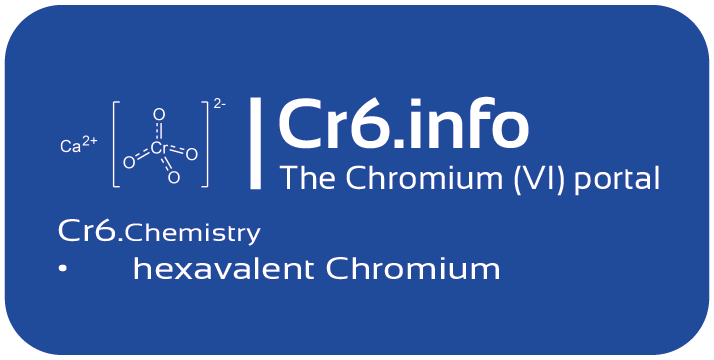Cr6.info - Science
%20oxidation%20temperature.png)

Calcium chromate (CaCrO4)
EC number: 237-366-8
CAS number: 13765-19-0
EU CLP(1272/2008) - yes
EU REACH: Annex XVII, App2
ECHA substance infocard click here
ECHA regulatory obligations click here
Sodium chromate (Na2CrO4)
EC number: 231-889-5
CAS number: 7775-11-3
EU CLP(1272/2008) - yes
EU REACH: Annex XVII, App2, 4, 6
ECHA substance infocard click here
ECHA regulatory obligations click here
Chromium(VI) and its Compounds (Chromates) - History, Applications, and Risks
Introduction to History and Discovery
Chromium(VI) compounds, known as chromates, have played an essential role in science and industry since the 18th century. Chromium itself was first discovered in 1797 by the French chemist Louis Nicolas Vauquelin, who isolated it from the mineral "crocoite" (lead chromate). Soon after, it was understood that chromium forms various oxidation states, including the highly toxic Chromium(VI), which occurs in compounds like chromates and dichromates.
Applications of Chromates
Chromates have a wide range of industrial uses, from pigment production to metal surface treatment, corrosion resistance, and leather tanning. They are particularly notable for their application in the steel industry, where chromates improve the durability and oxidation resistance of metals. In the glass and ceramics industries, they are also used as coloring agents.
Unintended Formation of Chromates
Chromates can also form unintentionally, a critical issue in industrial processes. A common example is the oxidation of Chromium(III) to Chromium(VI) in metalworking or chemical industries, especially where chromium salts are involved. While Chromium(III) is stable in nature, under certain conditions—such as high temperatures, exposure to oxygen, or the presence of oxidizing substances—it can be converted to Chromium(VI). This unintentional formation is a serious concern since Chromium(VI) compounds are highly toxic and pose environmental hazards.
Artificial Production of Chromates
Most chromates, however, are deliberately produced through chemical processes. Typically, this involves the conversion of Chromium(III) compounds. Chromite ore (FeCr₂O₄) is subjected to a high-temperature reaction with oxygen and an alkaline agent, such as potassium carbonate, which produces chromate (CrO₄²⁻). This process serves as the foundation for most industrial chromates.
Health Hazards: Comparison to Asbestos
Chromium(VI) compounds pose significant health risks and are classified as highly carcinogenic. They readily enter the body and cause DNA damage, leading to lung cancer, gastrointestinal cancers, and other severe diseases. In this respect, there are parallels to the health hazards of asbestos fibers.
Both substances are notorious for causing severe respiratory illnesses, including cancer.
However, Chromium(VI) compounds often present even greater risks due to their chemical toxicity.
A comparison table about the hazard classes (H-statements) of both substances can be found on the left:
Conclusion
Chromium(VI) compounds, particularly chromates, are widely used but come with severe risks to both human health and the environment. The unintentional formation of chromates in industrial processes is a major challenge, as these compounds are extremely toxic and difficult to manage. Like asbestos, Chromium(VI) compounds demand strict handling regulations and protective measures to prevent long-term health hazards.
"...the history of a beautiful induction killed by a nasty little fact." (Karl Pearson's interpretation in 1912 of an original by Thomas Henry Huxley from 1870)
H-statements Cr (VI) compounds:
-
H350: May cause cancer.
-
H340: May cause genetic defects.
-
H372: Causes damage to organs through prolonged or repeated exposure.
-
H334: May cause allergy or asthma symptoms or breathing difficulties if inhaled.
-
H317: May cause an allergic skin reaction.
-
H318: Causes serious eye damage.
-
H302: Harmful if swallowed.
-
H312: Harmful in contact with skin.
-
H332: Harmful if inhaled.
-
H335: May cause respiratory irritation.
-
H410: Very toxic to aquatic life with long lasting effects.
H-statements asbestos:
-
H350: May cause cancer.
-
H372: Causes damage to organs through prolonged or repeated exposure.
-
H335: May cause respiratory irritation.
-
H315: Causes skin irritation.
-
H319: Causes serious eye irritation.
